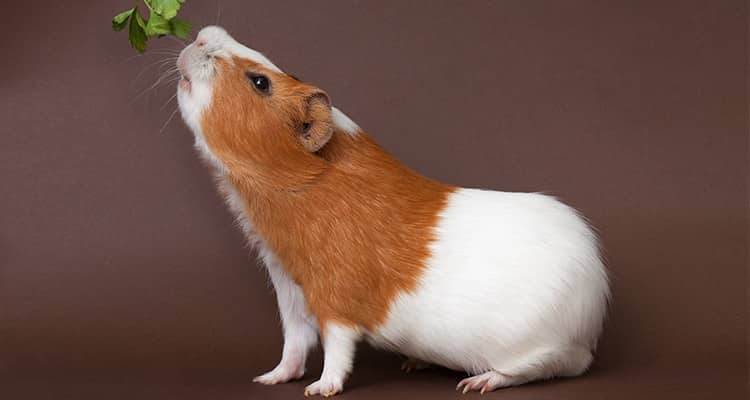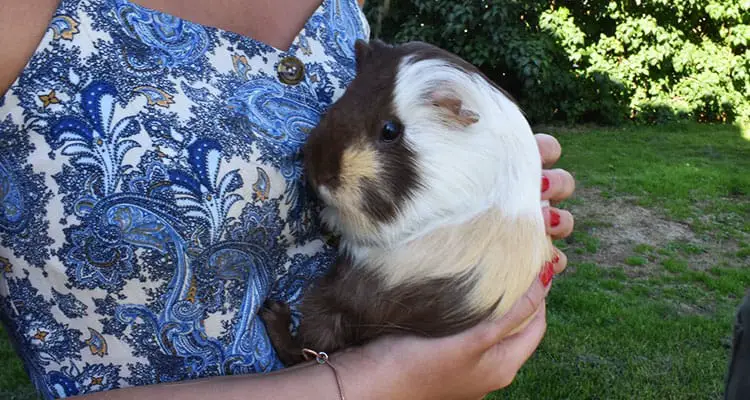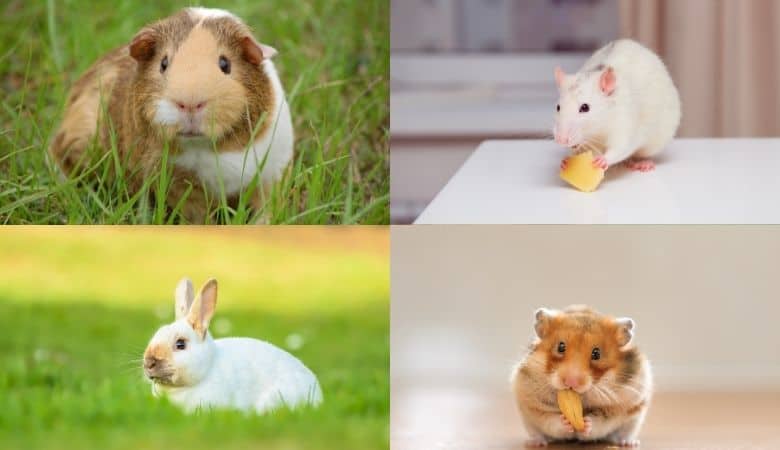Watch any pet competition show, and you will be shocked at how sharp some of the animals are.
If you are a rodent owner, you may be wondering just how intelligent your guinea pig is. Could it perform such a trick, or are you stuck with a pet you can’t challenge?
If they are intelligent, exactly how intelligent are they?
In all honesty, these little furry pigs are relatively smart. According to studies, they have a smart memory that helps them remember their path in the wild. As pets, these rodents will learn to recognize your voice, follow commands, and even perform tricks. With proper training, you can bring out their intelligence.
Read on to learn more about guinea pig intelligence and also how to draw it out of them using correct training.
Are Guinea Pigs Intelligent Animals?
Looking at your pet, you may think that all it does all day is make noise, eat, poop and repeat. But, during these activities, there is a lot of brainwork going on. Let’s look at five instances that show these pets are intelligent.
1. They remember their way back home
Tons of research and experiments prove that guinea pigs remember their pathways and find their way back home. At first, scientists thought the pigs use their strong sense of smell to find their way, but it has been proven that that’s not the case.
They instead use their kinesthetic memory. This means they master the way and use their memory to find their way.
When people started domesticating guinea pigs, they would wander off to look for food and water, but they would always come back even after wandering for a distance. In most cases, they would flee for their lives if they suspected a predator was near.
All these take memory and intelligent moves. We wrote a detailed article on how clever they are in the wild with very interesting facts about this. Check it out!
2. They show their emotions
They are like human beings because these rodents show their emotions. An example is if they are happy, you will see them hopping up and down repeatedly.
This behavior is known as “popcorning.” It is mostly observed on young guinea pigs though adults also show how happy they are. For instance, if they are happy to see you, they will show it.
That’s not all. When threatened, they will remain still and observe what is happening around them. Being observant helps the pet decide if the threat warrants fleeing or whether they should ignore it and move on with their activities.
If they are in a group, and the threat is real, you will see them scatter in different directions to confuse the predator. This is teamwork, which, as you may know, takes a smart mind.
3. They learn to respond to their names
The first thing you do when you get a pet is to name them. Like any other pet, guinea pigs learn to remember and respond to their names.
Obviously, they don’t know the meaning of the word, but they learn to associate your tone and voice with themselves. Thus, when you call them, they know the word is referring to them.
Test this theory with your furry friend. When they are in hiding, call them, and you may be surprised when they come out of hiding in response.
It may take some time for them to learn this, but they will, so don’t give up if it doesn’t happen the first time around.
4. They recognize you
As already established, guinea pigs are smart and learn to recognize you and respond when you call them. This recognition happens through voice, so talk to your pet regularly and spend time together.
Eventually, they will even know the sound of your footstep, so they are aware that you are approaching their cage.
For instance, when you bring your pet some food, watch their behavior. They may start squeaking and wheeking because they know you are coming to feed them.
Also, when you are around, check if they run towards the door of the cage waiting for you to pick them up or open the cage to feed them.
Guinea pigs also know you by your smell and will happily eat from your hand and play with you. All this takes intelligence on their part.
5. They learn tricks
Compared to cats and dogs, guinea pigs learn tricks a lot later. A dog, for instance, is best taught when they are a few weeks old, but your rodent will start learning when they are at least nine to ten months old.
So, don’t be in a hurry when you buy a young pet and they can’t seem to learn tricks.
When you are ready to start training your furry friend, spend a lot of time with them so they can get used to taking commands.
Also, make sure you train each pet at a time because learning in groups can be a little overwhelming. For these rodents, there are too many distractions which makes it hard to learn.
How to Train Your Guinea Pig And Challenge Their Intelligence

1. Start with the basics
Once you spend a lot of time with the pet, begin your training with something simple and basic. For instance, hide a carrot and encourage your pet to find it.
This activity is best when they aren’t in their cage because you have more space to work with. The challenge to discover where the food is will get your pet moving and exercise their brain power.
The activity may be simple, but it challenges all their senses and makes them curious, increasing their desire to discover new things. That’s not all. Your pet also gets a good dose of work our which is pretty healthy.
2. Use a maze
Next, build a small maze and where your guinea pig can walk around looking for a delicious treat. This will also test their sense of direction since they need to find their way back to the beginning of the maze.
Another good idea is using obstacles. For instance, use tubes where the guinea pig can scamper through to find food. Also, hide their favorite food under a box and let the pet figure out how to get the treat.
3. What to do when in their cages
Obviously, you won’t be spending every waking moment giving attention to your guinea pig, but there are tricks you can teach them when they are in their cage.
Choose something simple like hanging a lettuce leaf in the cage. Your pet will have to exercise its brain to figure out how it will reach the food.
You can use the same position for a while before switching gear and giving them a new challenge. Also, you can teach them to identify colors, especially primary colors. These are bright and will be easy for your pig to play around with.
To do this trick, always fill a specific colored bowl with the food, then put all the bowls in a row. Your pig will find the food and note the bowl color. Do this several times until you notice they always go to that bowl whenever you bring them food.
Next, switch things up by arranging the bowls but put no food in them. If your pig goes to the right bowl, reward them by pouring the food.
Mix the bowls up so you can see if they recognize which bowl should have food. You can do the same with water, and eventually, your pig will learn to differentiate between the water and food bowl.
Other Tricks You Can Teach Them

1. Teach your guinea pig to step up on your hand
What you need: Your guinea pig, your hands, your pet’s favorite treat
Procedure:
- Place one hand on the ground and hold your pet’s favorite treat on the other.
- Lure your furry friend with the treat and direct them to where your hand is (the hand flat on the ground)
- Now, put the treat high above such that your pet must step up on your flat hand to reach it.
- When your pet tries to step up, say the command “step up” and offer them the treat once they successfully step on your hand.
- Repeat the process a few days until your guinea pig can step up even when a treat isn’t offered
2. Teach your pig to respond when you call them
What you need: Your guinea pig and some treats
Procedure:
- Let your guinea pig enjoy some floor time and explore
- Sit on the ground with a few treats and call your guinea pig, tapping your leg. Use a command such as “come here piggy or whatever their name is”
- Use a treat to lure them towards you
- Once they respond, offer them the treat
- Repeat the command a few days until they learn to come to you even when you don’t offer treats
Guinea Pig Intelligence Compared to Other Pets

Now, we can’t grade guinea pigs with numbers, but research has shown how you can compare their intelligence with other animals. Guineas are smart, and they can easily associate words with actions. They are great at remembering things which further shows how smart they are.
So, how do they compare to other animals? Let’s find out.
1. Guinea pigs vs. hamsters
Around 90 percent of people confuse hamsters and guinea pigs, and with good reasons. First, they both have four legs, but guineas use all four while hamsters use two. Secondly, their eyes are little and round and are found on the side of the head.
Lastly, their teeth keep growing. But, although they are similar, how do they compare in terms of intelligence?
According to studies, hamsters have fewer neurons than guinea pigs, which means they have a smaller grey area. In fact, research has shown that hamsters have a smaller grey area than almost all rodents.
In terms of training, hamsters are also obviously harder to train since they have a shorter memory span. All these facts seem to suggest that guinea pigs are smarter than hamsters.
2. Guinea pigs vs. rats
Science has proven that hamsters and rats have the same number of neurons. However, some rats have more neurons, but they still don’t compete with guinea pigs.
For this reason, guineas learn faster than rats which makes them more intelligent than rats.
3. Guinea pigs vs. rabbits
In terms of neurons, rabbits have more than guinea pigs. This obviously seems to suggest they are more intelligent than these little pigs, but that’s not the case.
In fact, the two compete pretty closely. A rabbit’s short-term memory only lasts for a short while, making guinea pigs winners since theirs lasts longer.
But, rabbits typically learn more complex tricks than what your guinea pigs can. In short, rabbits are brighter than guineas, but only to a certain extent.
Luckily, both make excellent pets, although they have their pros and cons. For instance, guineas are perfect if you won’t spend a lot of time with their pets since they don’t mind staying in their cage until it’s floor time.
However, Rabbits will not like this because they like being in open spaces where they can play freely.
4. Guinea pigs vs. cats
Cats have more grey matter than guineas, and by far, they are more intelligent than guinea pigs. Cats can remember things better and faster and learn quicker than guinea pigs. There is a misconception that cats and guinea pigs can’t live together.
While the claims are not baseless, the two pets can live together comfortably with a little bit of planning.
First, keep in mind that one is a predator and the other prey, which is the genesis of their complicated relationship. So, the two need to be trained on living together, especially if your cat sees the guinea as prey. This means you must be careful if you plan on keeping the two.
Naturally, the instinct in cats is to hunt guinea pigs.
Secondly, guineas are easily frightened, which makes it hard to adjust when a cat is around. This is especially true if the cat sees the guinea as prey.
Even cats who don’t care about guineas may be too frightening for the fragile furry pet. The watchful curious eye and laying around their cage may be too much for the guinea. The best thing is not to mix the two.
5. Guinea pigs vs. dogs
Without a doubt, guinea pigs can’t be smarter than dogs. Although both can recognize their owners, dogs can do so much better than these cute little pigs.
Think of a service dog, for instance. The level of intelligence can’t be compared with that of a guinea pig. It would be absurd to even try. Luckily, with careful planning, these two pets can live together and form a special bond.
Pet experts say you should make the introduction smooth and stress-free, especially for your guinea pig. Since dogs have higher intelligence, you should train them to be calm and friendly with your guinea pig before any introductions are made.
However, the natural relationship between the two is that of prey and predator, so make sure you are careful when interacting.
Remember, your guinea is fragile and may get frightened easily, so don’t leave them alone with your dog. When they interact, be sure to give your guinea pig enough hiding space where they can retreat if they need a break from your dog’s energy and playfulness.
The best way to introduce them is when your dog is a pup.
Can You Test Your Guinea Pig’s Intelligence?
Yes, it’s possible to test how sharp your guinea pig is. You can use the tricks we mentioned earlier to train your pig. Alternatively, you can use these tricks to test your pet’s intelligence.
- Pick three transparent glasses and a small piece of carrot or your pig’s favorite treat
- Place the carrot under one of the cups and put your pig to the test. The idea is to have the pig find and knock over the glass with the treat
- Time how long it takes for your pig to knock over the glass with the treat
- Repeat the process a few times on separate days
- Check your pig’s progress by checking how much time they take to find the correct glass each time
Verdict
Your guinea pig may not win a competition, but they are smart enough to learn basic tricks. Also, guinea pigs are hardy and generally very healthy animals.
They aren’t prone to dental diseases or bladder stones. They are easy to care for because all they need is freshwater, veggies, hay, vitamin c supplements, and a small amount of pelleted food.
If you have kids, guinea pigs make great pets for children. They aren’t as fragile as rabbits and are better than other smaller rodents like hamsters and gerbils.
If you need something in between smaller rodents and bigger pets, this will be your best pet. Now that you know they are intelligent, you can start training your guinea pig.


